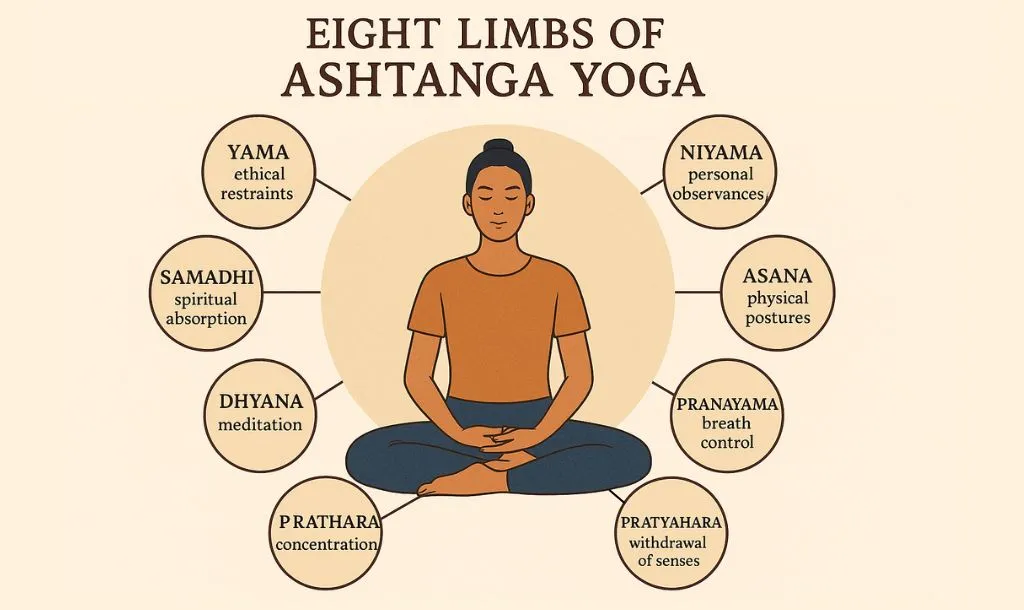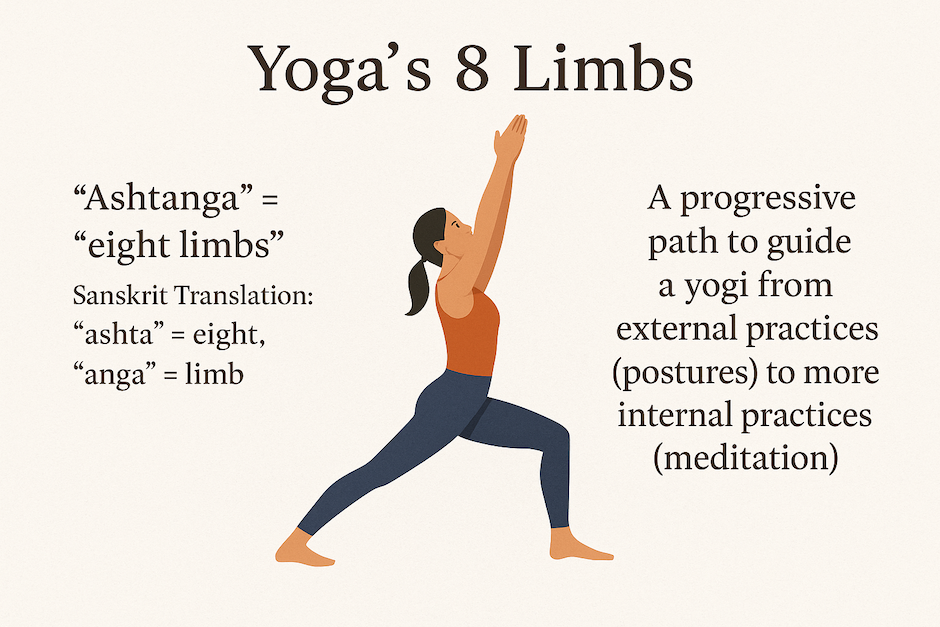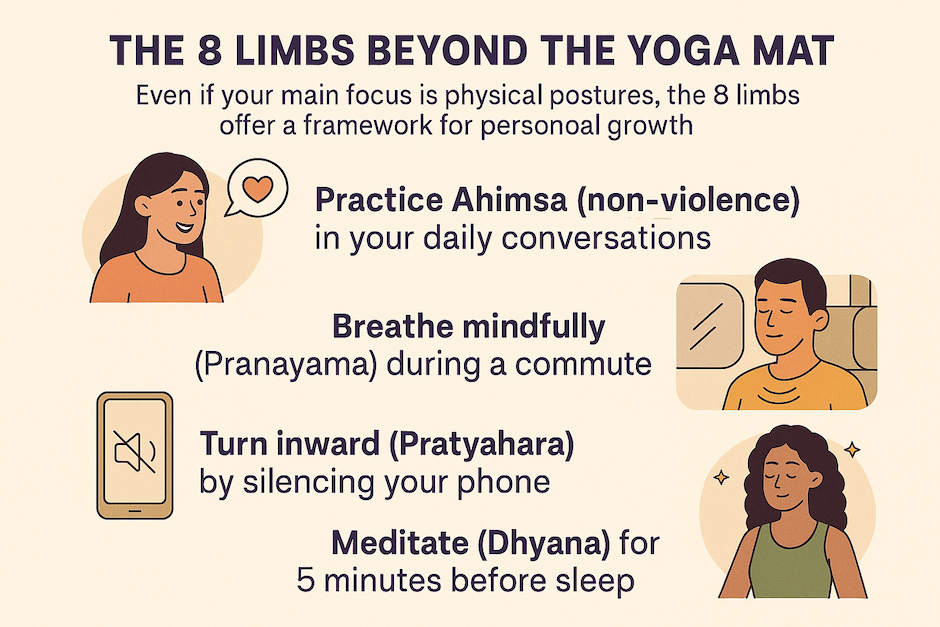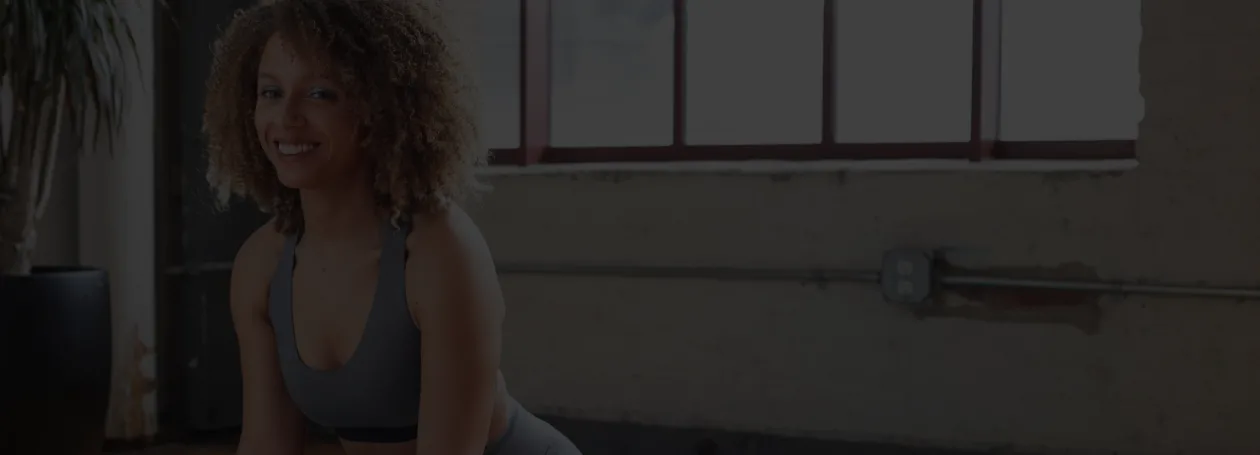

What if ancient wisdom from over 2,000 years ago could transform your modern yoga practice and daily life? That wisdom is fully accessible through the 8 limbs of Ashtanga Yoga!
The 8 limbs of Ashtanga Yoga, also known as the eight-fold path, are more than ancient philosophy; they are a practical, timeless framework for navigating modern life with self-awareness, intention, and spiritual depth.
First outlined by the sage Patanjali in the Yoga Sutras around 200 BCE, these interconnected principles guide yogis toward physical well-being, mental clarity, and spiritual growth. These include:
In this comprehensive guide, you'll discover what the 8 limbs of Ashtanga Yoga are, their real-life applications, and how they interconnect to create a complete and holistic yogic lifestyle.
Ready to practice authentic yoga and bring ancient yoga wisdom into your modern life?
[inline-CTA-1]

The concept of the 8 limbs comes from the Yoga Sutras of Patanjali, written around 200 BCE. Patanjali, regarded as one of yoga’s most influential sages, compiled ancient teachings into a structured system for personal growth and self-realisation.
The term “Ashtanga” literally means “eight limbs” in Sanskrit (“ashta” = eight, “anga” = limb). These limbs are steps on a progressive path, guiding a yogi from external practices like ethical living and posture to more internal practices like meditation and spiritual absorption.
Learn more about Ashtanga Yoga in the complete guide!
While modern yoga often focuses on physical postures, the full eight-limb system reveals yoga as a holistic life philosophy rather than just a workout.
Here’s a brief overview of the 8 limbs of yoga:
To experience how these eight limbs help you live and balanced and disciplined life, try this group class on Ashtanga Yoga today!
The word “yama” originally meant “bridle” or “rein.” Much like reins guide a horse, the Yamas are moral restraints that help you govern how you interact with the world. These are foundational ethical principles for living in harmony with others and the environment.
The five Yamas are:
Modern Application: Whether on or off the mat, Yamas encourage ethical living. For example, Ahimsa inspires peaceful communication while Brahmacharya prevents overindulgence.
Niyamas are personal observances that guide your inner world—how you treat yourself, your habits, and your spiritual mindset.
The five Niyamas are:
Modern Application: Incorporate these by journaling, meditating, or simply cultivating more awareness of your reactions and choices. When your inner world is calm, your outer actions follow suit.
Asana refers to the physical poses of yoga. Originally designed to prepare the body for stillness and meditation, Asana in modern practice also improves strength, flexibility, and balance.
Traditionally, there are 84 asanas—but most classes focus on a curated sequence. In Ashtanga Yoga, asanas are often practiced in a structured series that builds heat, flexibility, and focus.
Learn about the Ashtanga Yoga Primary Series here!
Modern Application: While yoga classes today often focus on Asanas for physical benefits, their deeper purpose is to create comfort and stability for inner work.
“Prana” means life energy, and “ayama” means extension or control. Pranayama involves consciously regulating the breath to direct and expand your life force.
In Ashtanga Yoga, breath and movement are synchronized, and control of breath is central to building focus and stamina.
Modern Application: Techniques like alternate nostril breathing or Ujjayi help reduce stress, enhance focus, and balance energy.
Pratyahara is the practice of consciously withdrawing your attention from external stimuli. Think of it as turning your senses inward—not tuning out the world, but choosing not to react to it.
You may have experienced Pratyahara during Corpse Pose (Savasana), when you're fully present, yet unaffected by your surroundings.
Modern Application: Turning off devices and practicing silence are simple ways to experience Pratyahara in the modern world.
Dharana is focused concentration or binding your attention to a single point. It’s the bridge between quieting the senses and achieving full meditation.
Modern Application: Meditation with mantras or visualization exercises helps develop Dharana, improving mental clarity and calmness.
Want to give Mantra Meditation a try? Book this group class for free!
Dhyana is a state of uninterrupted meditation, where focus becomes effortless and the mind transcends thought. This limb arises naturally as you refine the earlier limbs, especially Dharana.
Modern Application: Regular meditation fosters emotional resilience, mindfulness, and a deeper connection to self.
Samadhi is the final limb—a state of complete oneness and liberation. In Samadhi, the ego dissolves, and you're no longer separate from your focus of meditation. It’s often described as a blissful union or enlightenment.
While this may sound abstract or unattainable, glimpses of Samadhi can appear in moments of deep peace, joy, or profound clarity.
Modern Application: While rare, moments of profound peace during meditation hint at the state of Samadhi, motivating continued practice.

While the limbs are traditionally presented sequentially, you do not need to master them in order. The eight limbs function more like an interconnected web—informing and supporting one another—and modern practitioners often experience multiple limbs simultaneously.
For example, simply practicing asana can cultivate awareness (Dharana), breath control (Pranayama), and even moments of stillness (Dhyana), even if you haven’t intentionally focused on those limbs.
Many students begin with the physical practice of asana, and through that experience, become more mindful of their breath, behavior, and internal patterns. Over time, this leads naturally to exploring Yama, Niyama, or meditative practices—without ever consciously “starting” at limb one.
Even if your main focus is physical postures, the 8 limbs offer a framework for personal growth:
Each limb contributes to and supports the whole, regardless of the entry point.
The coaches at MyYogaTeacher emphasize the importance of experiencing the holistic benefits of yoga in how you live every day. The 8 limbs guide you to cultivate a healthier body, clearer mind, and more compassionate heart.
[inline-CTA-2]
The 8 limbs of Ashtanga Yoga provide a flexible roadmap you can adapt to your current lifestyle and practice level.
When starting out, focus on integrating the first two limbs into daily life:
Tip: Even a few minutes of Pranayama after asana can ground your practice.
As you progress, you’ll naturally be drawn to subtler practices:
Tip: Journaling about your Niyama reflections can deepen self-awareness.
With regular practice, meditation becomes a natural extension of your yoga:
Tip: Authentic practice is key, and advanced stages require guidance to navigate subtle experiences.
At MyYogaTeacher, our certified instructors are trained in the full spectrum of yoga philosophy. They guide you step-by-step, from building strong foundational practices to experiencing the transformational power of meditation.
The 8 limbs of yoga, as outlined in Patanjali’s Yoga Sutras, are:
These steps guide yogis toward self-mastery and spiritual awakening.
Not necessarily. While traditionally presented as sequential, many practitioners explore multiple limbs at once. For example, asana practice naturally leads to better awareness of Yama and Niyama, and simple Pranayama can be incorporated early on. It’s a flexible framework and not a rigid one.
Mastering the 8 limbs is considered a lifelong journey. Even experienced yogis continually refine their understanding of each limb. The goal isn’t perfection but steady progress and self-discovery.
No. The 8 limbs form the philosophical core of all yoga styles, not just modern Ashtanga Yoga. Whether you practice Hatha, Vinyasa, or Iyengar, the eight-fold path offers a universal roadmap for holistic living.

Receive personalized guidance tailored to your unique fitness goals, live with a dedicated coach—no credit card required.